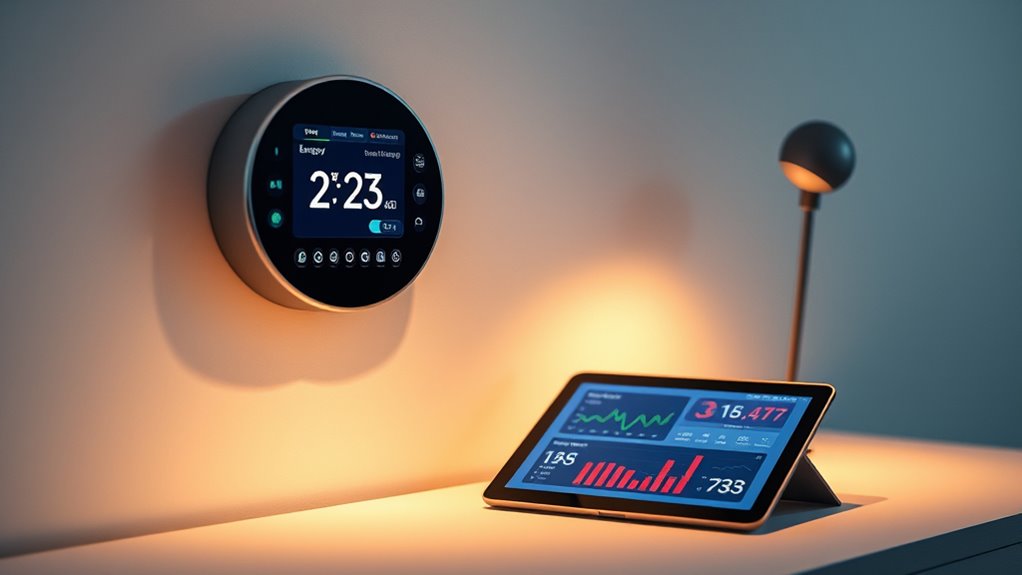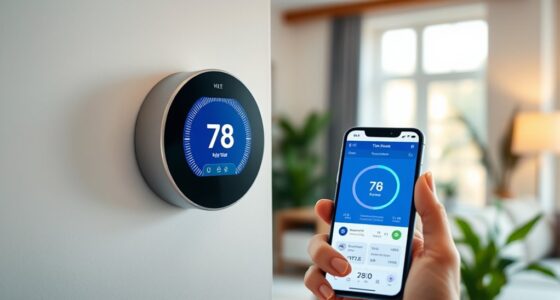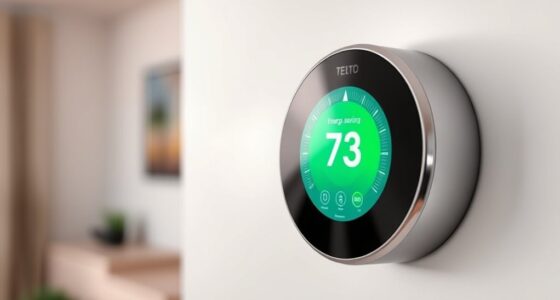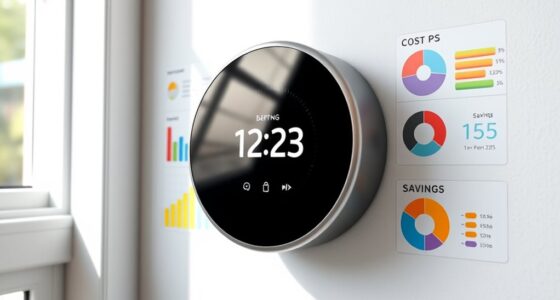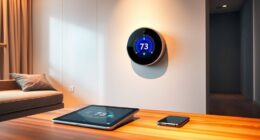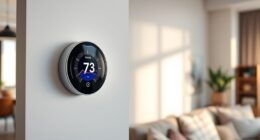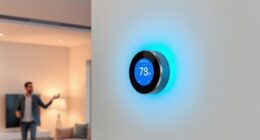To understand your Ecobee or Nest energy reports, start by checking the dashboard for an overview of your consumption and efficiency. Look at daily and weekly trends to spot high-usage periods and habits. Pay attention to cost and savings data, and analyze how your thermostat settings change over time. Recognizing peak times and long-term patterns can help you optimize your system. Keep exploring to uncover more tips for smarter energy management.
Key Takeaways
- Review total energy consumption, costs, and efficiency metrics to identify high-use periods and potential savings.
- Analyze daily and weekly patterns to understand habits and detect anomalies or spikes in usage.
- Use sensor data and visualization tools to interpret temperature adjustments and system performance trends.
- Compare seasonal variations to optimize settings and balance comfort with energy efficiency.
- Regularly examine reports to make informed decisions for long-term system improvements and cost reduction.
Navigating Your Energy Dashboard
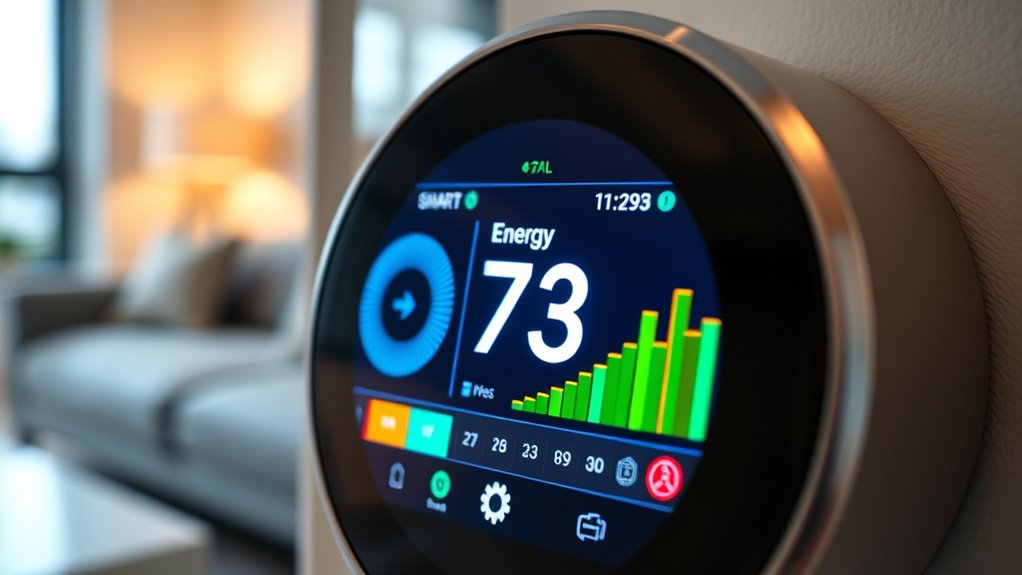
Your energy dashboard is designed to give you a clear view of your consumption and efficiency at a glance. If you have a smart thermostat like Ecobee or Nest, the dashboard lets you easily monitor how much energy you’re using daily and weekly. This insight helps you identify patterns and opportunities to improve energy efficiency. You can see detailed data on your heating and cooling habits, enabling you to make smarter adjustments. The intuitive layout highlights your energy use trends, making it simple to understand where you can save. By regularly checking your dashboard, you become more aware of how your thermostat settings impact your overall energy consumption. Understanding energy data visualization and how different filtration methods affect air quality can further enhance your ability to optimize your system and reduce waste while maintaining comfort. Additionally, learning about energy-saving tips can help you implement practical changes for even better efficiency.
Understanding Daily and Weekly Reports
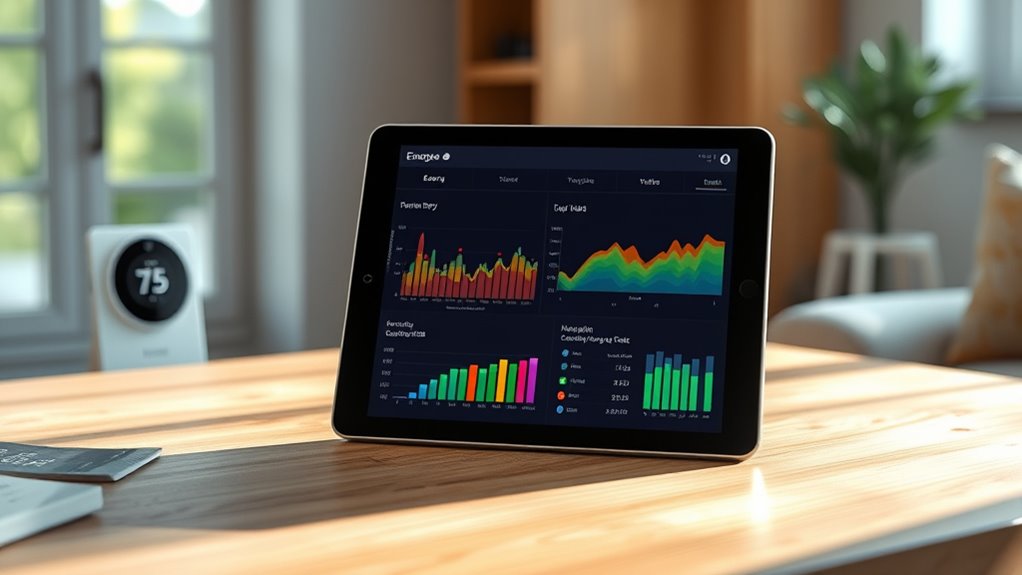
Understanding your daily and weekly reports helps you recognize how your energy use changes over time. You’ll see how data collection methods influence the accuracy of these insights, and key metrics reveal patterns in your consumption. By interpreting usage patterns, you can make smarter decisions to optimize your energy efficiency. For example, analyzing SEER ratings can help you choose more efficient cooling settings and reduce costs. Additionally, understanding Vetted – Nightingale Studio products related to energy management can provide insights into optimizing your system performance. Incorporating Ford Tuning techniques can also inspire strategies to enhance your system’s overall efficiency and responsiveness.
Data Collection Methods
How do energy providers gather the data that fuels daily and weekly reports? They rely on sensors placed strategically within your system to monitor energy use. Proper sensor placement is vital for ensuring data accuracy, capturing precise readings of your heating, cooling, and other appliances. These sensors transmit data continuously to centralized systems, which compile and analyze the information. Accurate sensor placement is essential for generating reliable reports and understanding your energy habits effectively. Additionally, data-driven strategies allow providers to tailor recommendations for energy efficiency based on the collected data.
Key Metrics Explained
Have you ever wondered what the numbers in your energy reports really mean? These key metrics reveal how effectively your system manages energy efficiency and help guarantee data accuracy. For example, daily reports show your energy consumption per day, highlighting peaks and trends. Weekly summaries give you an overview of overall efficiency and savings over time. Key metrics often include:
- Total energy used
- Average temperature settings
- Cost savings
- System runtime
Understanding these figures helps you identify patterns and optimize your system. Accurate data ensures you’re making informed decisions to improve energy efficiency. By focusing on these metrics, you can fine-tune your thermostat settings and reduce waste, ultimately saving money and reducing your environmental impact. Additionally, recognizing the benefits of hydrogen fuel cells can inspire sustainable choices and contribute to a greener future. Being aware of environmental considerations in your energy use encourages eco-friendly habits and helps protect natural resources. Incorporating vertical storage solutions into your energy management can further enhance organization and efficiency.
Interpreting Usage Patterns
Ever wondered what your daily and weekly energy reports reveal about your habits? These reports show patterns in your energy consumption, helping you understand how your devices perform over time. You might notice spikes during certain hours, indicating when your system works hardest, or identify days when your energy use drops. Recognizing these trends allows you to adjust your routines for better efficiency. For example, if your smart thermostat shows frequent adjustments, it could signal that your device isn’t performing the most effective, or that your habits are changing. Interpreting these patterns helps you pinpoint opportunities to save energy and improve device performance. By regularly reviewing your reports, you gain insights into your energy habits, making it easier to optimize your home’s efficiency. Additionally, understanding automation in business can provide context for how smart systems are designed to adapt and optimize based on usage data. Monitoring your energy data also enables you to identify inefficient usage patterns, which can lead to targeted improvements in your home management. Being aware of regulatory considerations related to energy use can further help you make compliant and sustainable choices.
Interpreting Usage Patterns Over Time
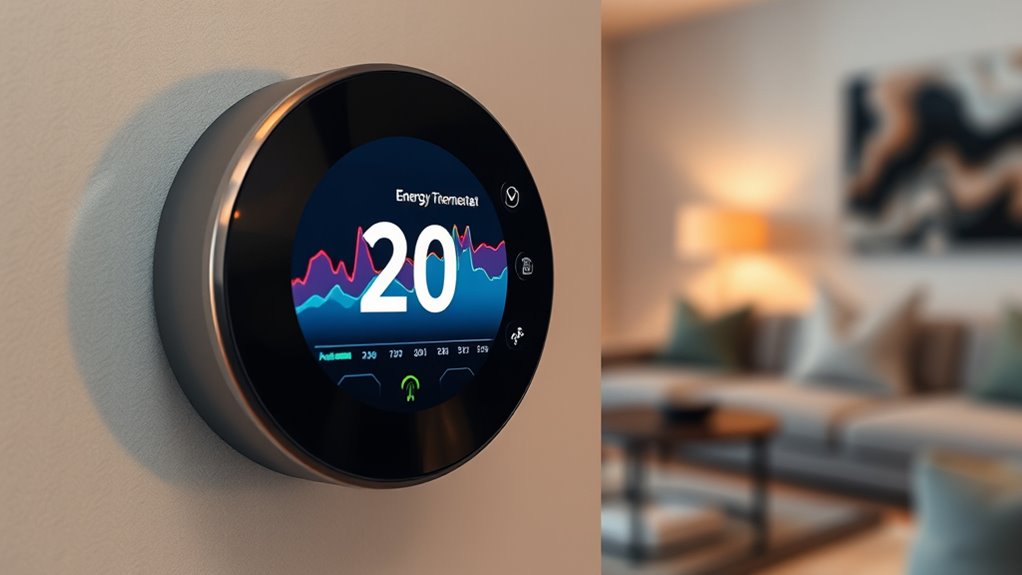
Understanding your energy usage patterns over time can reveal valuable insights into your consumption habits and help identify opportunities for savings. By analyzing trends, you can see how different devices impact your overall energy consumption and monitor their performance. Look for patterns like spikes during certain hours or days, which may indicate inefficient device performance or unnecessary usage. Recognizing the importance of high refresh rates in related technology can also inform your decisions about energy-efficient devices, as they often operate more smoothly and with less strain on power sources. Additionally, monitoring for persistent pain or skin changes may help identify underlying issues that could affect your energy-efficient equipment or home environment. Consider these points: – Peak usage times highlight when energy consumption is highest – Consistent drops may signal device issues or maintenance needs – Seasonal variations reveal how climate affects your energy use – Long-term trends help you plan for future energy efficiency upgrades. Paying attention to the skin’s response to eye patches can also provide insights into potential sensitivities and improve your skincare routine. Interpreting these patterns allows you to optimize device performance and reduce waste, ultimately lowering your energy costs.
Decoding Cost and Savings Data
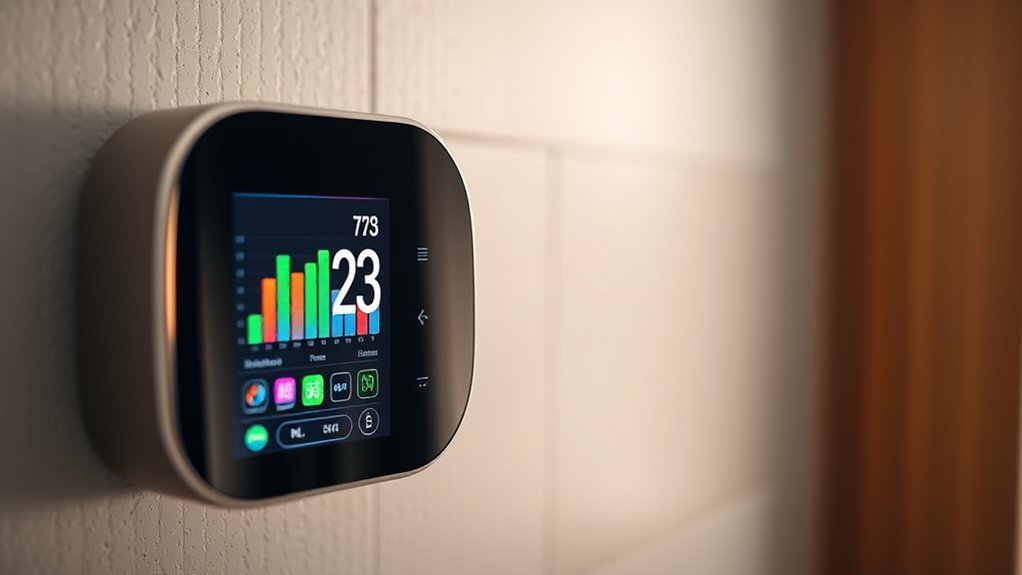
Decoding your energy cost and savings data can reveal exactly where your money goes and how to cut costs effectively. A thorough cost analysis helps you identify high-expense periods and inefficient usage patterns. By understanding these details, you can develop targeted savings strategies, such as adjusting your thermostat during peak times or optimizing device schedules. Look for trends in your reports that correlate with higher bills, and consider how small changes might reduce expenses. Many smart thermostats provide detailed cost breakdowns, making it easier to prioritize actions that yield the best savings. Regularly reviewing this data empowers you to make informed decisions, maximize efficiency, and ultimately lower your energy bills without sacrificing comfort. Additionally, understanding your energy consumption patterns can help you identify specific appliances or systems that contribute most to your costs. For example, recognizing inefficient HVAC operation can lead to more precise adjustments and energy savings, especially when combined with insights from air purifier efficiency and other home devices.
Analyzing Temperature Settings and Adjustments
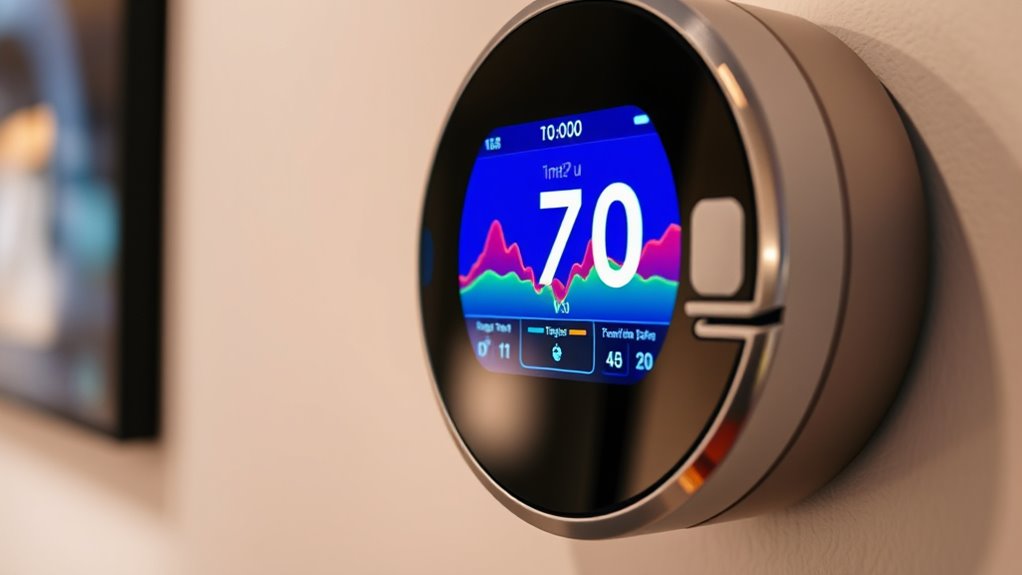
Your energy report shows how temperature adjustment patterns impact your consumption. By examining these patterns, you can identify times when changing settings makes a real difference. Finding the most effective temperature settings helps you save energy without sacrificing comfort. Recognizing the importance of hydration and nutrition in maintaining overall health can also influence your energy efficiency. Proper maintenance of your thermostat and understanding indoor air quality can further optimize your energy usage and comfort. Additionally, being aware of angel numbers related to love and spiritual growth can provide insights into your emotional well-being, which indirectly affects your energy management.
Temperature Adjustment Patterns
Analyzing temperature adjustment patterns reveals how you modify your settings based on factors like time of day, weather, or comfort needs. You might notice trends such as increased cooling during afternoons or heating in mornings. These adjustments often stem from adaptive scheduling, which learns your routines, and sensor calibration, ensuring accuracy. You may also see manual tweaks during extreme weather or unexpected changes. Recognizing temperature regulation helps you understand how your system responds to various conditions. Understanding these patterns helps optimize energy use and comfort. Keep an eye on:
- Variations in temperature settings during different times
- Adjustments in response to weather shifts
- Manual overrides versus automated changes
- Frequency of sensor calibration or calibration adjustments highlighting the importance of AI-driven analytics in maintaining system accuracy.
Optimal Temperature Settings
Finding the ideal temperature settings involves balancing comfort with energy efficiency. To do this, consider how humidity control impacts indoor comfort—maintaining proper humidity levels prevents stuffiness and reduces the need for extreme temperature adjustments. Utilize occupancy detection features on your smart thermostat; when it detects you’re home, it can adjust temperatures for comfort, and when you’re away, it can save energy. Setting your thermostat to slightly higher temperatures in summer or lower in winter can optimize energy use without sacrificing comfort. Regularly review your data to identify patterns, ensuring your settings respond effectively to occupancy and humidity changes. Fine-tuning these factors helps you save on energy bills while maintaining a comfortable environment year-round.
Recognizing Peak Usage Periods
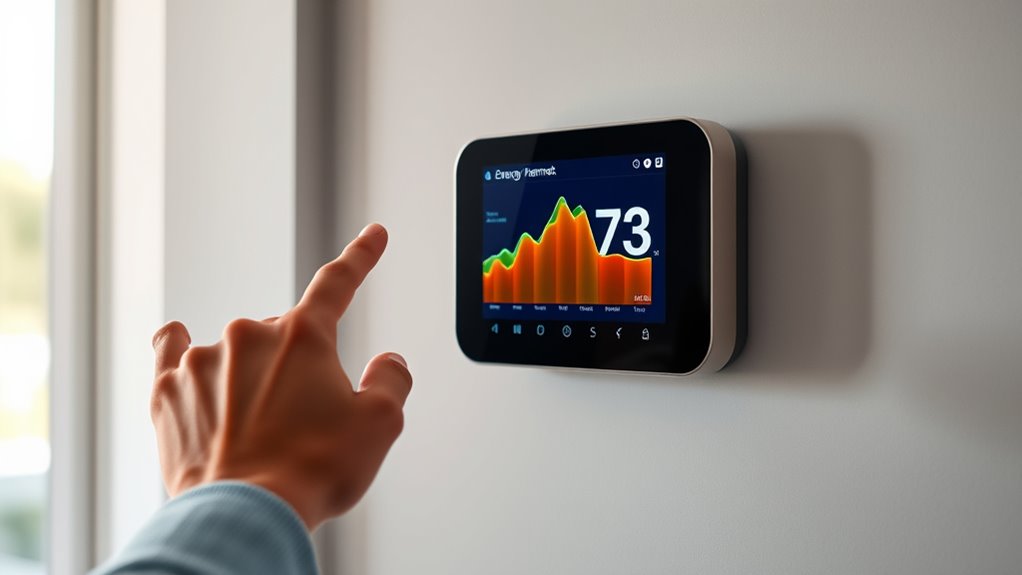
Recognizing peak usage periods is essential for managing energy consumption effectively. By identifying peak hours, you can avoid unnecessary energy waste and optimize your system’s efficiency. Usage peaks typically occur during specific times when most households are active, like mornings and evenings. To spot these periods, look for patterns such as increased thermostat adjustments or higher energy reports during certain hours.
Consider these indicators:
- Sudden spikes in energy consumption during specific times
- Regular increases in usage during mornings or evenings
- Elevated energy costs coinciding with certain hours
- Consistent trends over days or weeks showing usage peaks
Knowing when your peak hours happen allows you to plan better, reduce costs, and improve overall energy management. Stay alert to these patterns to make smarter, more efficient choices.
Comparing Yearly Trends for Better Efficiency
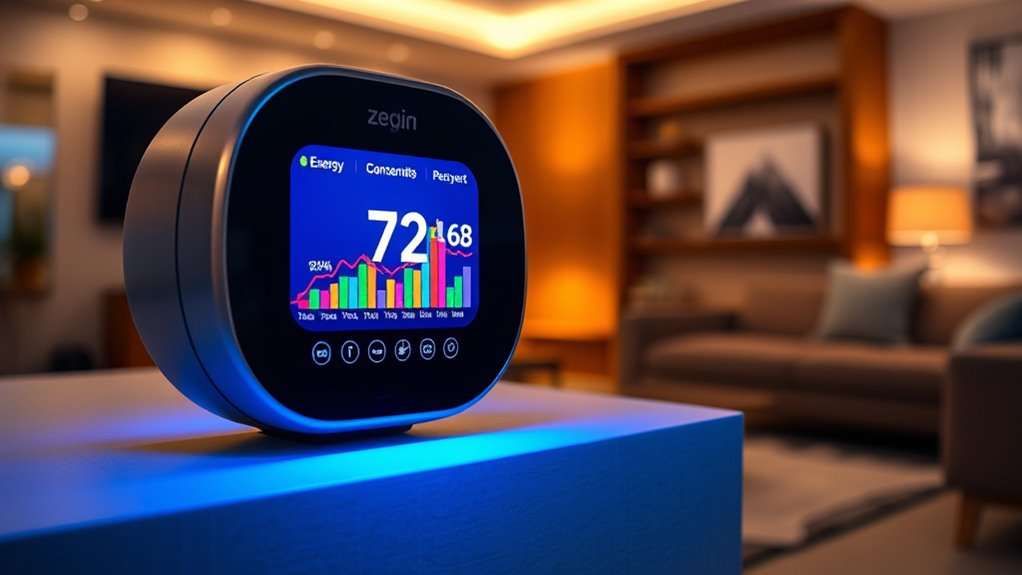
By examining yearly energy consumption patterns, you can identify long-term shifts and opportunities for improvement. Your smart meter provides detailed data that reveals how your energy use changes across seasons and years. Comparing these trends helps you spot periods of unnecessary consumption or increased efficiency. For example, if your energy consumption spikes during winter, you might consider better insulation or adjusting your thermostat settings. Tracking these patterns over time allows you to see if recent changes, like upgrading to a more efficient thermostat, are making a difference. By analyzing your energy reports regularly, you gain valuable insights into your home’s energy habits. This knowledge empowers you to make informed decisions that improve your overall efficiency and reduce costs over the long term.
Identifying Opportunities for Optimization
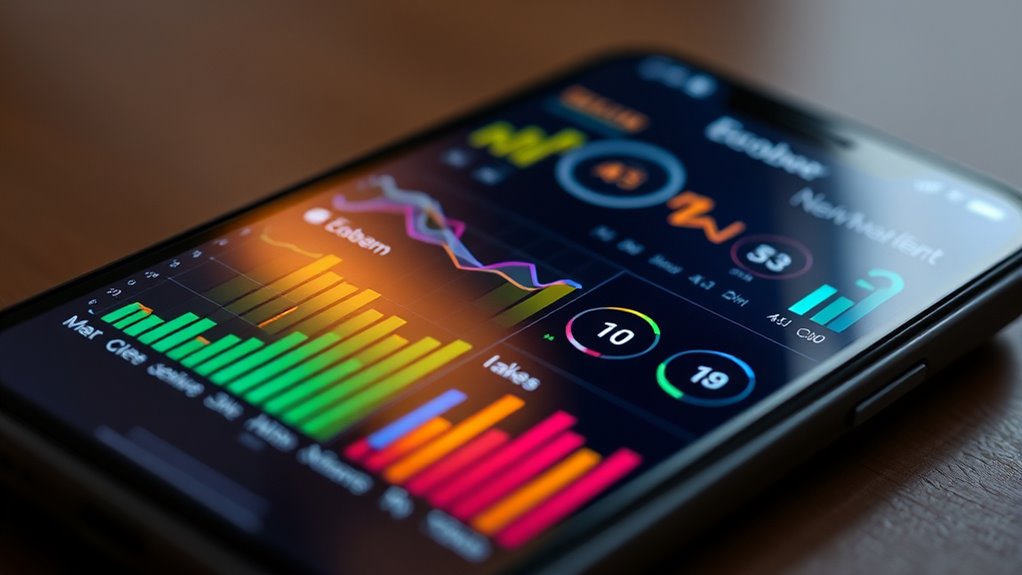
To enhance your energy consumption, you need to analyze your usage data carefully and identify areas where efficiency can be improved. Focus on opportunities like schedule optimization and equipment performance. Look for patterns that suggest unnecessary heating or cooling during unoccupied times, or equipment running inefficiently.
Analyze your usage data to find opportunities for schedule tweaks and equipment improvements.
Consider these key areas:
- Adjusting your thermostat schedule to match actual occupancy
- Identifying equipment that operates beyond its ideal performance
- Recognizing times when energy use spikes unexpectedly
- Ensuring your HVAC systems are functioning properly and efficiently
Setting Goals Based on Your Data Insights
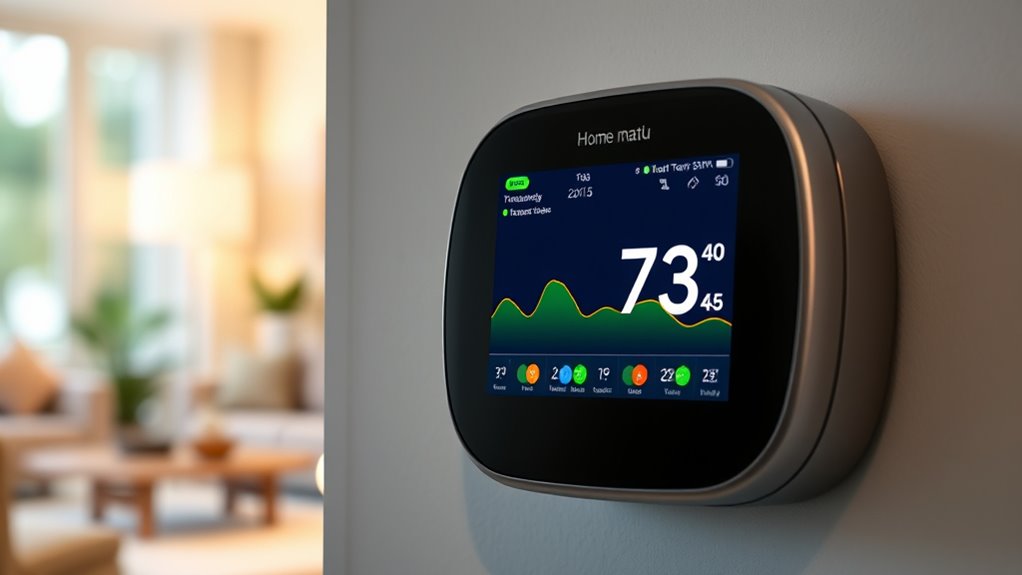
Using the insights gained from your energy data, you can now set clear and actionable goals to improve efficiency. Focus on energy saving by establishing specific targets, like reducing consumption during peak hours or lowering overall usage by a certain percentage. Make your goals SMART—Specific, Measurable, Achievable, Relevant, and Time-bound—to guarantee they’re practical and trackable. For example, aim to cut heating and cooling costs by 10% over the next three months. Regularly review your data to monitor progress and adjust your goals as needed. Setting these smart goals keeps you motivated and ensures your efforts lead to meaningful energy savings, making your home more efficient and environmentally friendly.
Frequently Asked Questions
How Can I Customize My Energy Report Notifications?
You can customize your energy report notifications by exploring the app’s notification settings. First, open your thermostat’s app and navigate to the notification preferences. From there, you can enable or disable specific alerts, adjust how often you receive reports, and choose the types of energy data you want to be notified about. This energy report customization allows you to stay informed and manage your energy use more effectively.
What Do Sudden Spikes in Energy Use Indicate?
When you see sudden spikes in energy use, it often signals unexpected changes in your energy consumption or usage patterns. These abrupt increases can indicate appliances turning on unexpectedly, increased activity, or potential issues like malfunctioning equipment. Recognizing these spikes helps you identify inefficiencies, adjust your habits, or detect problems early. Pay attention to these fluctuations—they reveal important insights about your home’s energy habits and can help you optimize your efficiency.
Can I Compare Multiple Device Data in One Report?
You can definitely compare multiple device data in one report through device benchmarking and data integration. This approach lets you see how each device performs relative to the others, helping you identify efficiency issues or areas for improvement. By integrating data from different devices, you gain an all-encompassing view of your energy usage, making it easier to optimize your system and reduce costs effectively.
How Accurate Is the Cost Estimate Provided?
Oh, the sweet illusion of perfect cost accuracy—like trusting a weather forecast in a tornado. Your report’s reliability hinges on data quality, but don’t expect pinpoint precision every time. While reasonably close, expect some variation in cost estimates. So, if you’re craving absolute certainty, buckle up. Your report’s reliability is good but not infallible, proving that even smart thermostats have a sense of humor about their cost predictions.
Are There Privacy Concerns With Sharing My Energy Data?
You might have privacy concerns about sharing your energy data, and that’s understandable. When you share data, make sure the company has strict privacy policies and data security measures. Be aware that data sharing could potentially expose your usage patterns or personal habits. Always review privacy settings and permissions, and consider opting out if you’re uncomfortable with how your information is used. Your privacy should always come first.
Conclusion
Now that you’ve unraveled the secrets behind your energy reports, you’re armed with a map to your home’s efficiency treasure chest. Think of your data as a guiding star, lighting the path to smarter energy habits. With each insight, you’re tuning your system like a skilled musician, creating harmonious savings. Embrace these revelations, and watch your energy use transform from a tangled web into a symphony of savings and comfort.
